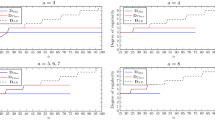Abstract
Recently, F. Ivanov, E. Krouk and V. Zyablov proposed new cryptosystem based of Generalized Reed–Solomon (GRS) codes over field extensions. In their approach, the subfield images of GRS codes are masked by a special transform, so that the resulting public codes are not equivalent to subfield images of GRS code but burst errors still can be decoded. In this paper, we show that the complexity of message–recovery attack on this cryptosystem can be reduced due to using burst errors, and the secret key of Ivanov–Krouk–Zyablov cryptosystem can successfully recovered in polynomial time with a linear–algebra based attack and a square–based attack.
Access this chapter
Tax calculation will be finalised at checkout
Purchases are for personal use only
Similar content being viewed by others
Notes
- 1.
The code for our implementation is available on https://github.com/kirill-vedenev/ikz-cryptanalysis.
- 2.
The code for our implementation of this and the next step is available on https://github.com/kirill-vedenev/ikz-cryptanalysis.
References
Aragon, N., et al.: BIKE - Bit-Flipping Key Encapsulation. https://bikesuite.org
Aragon, N., Blazy, O., Deneuville, J.C., Gaborit, P., Zémor, G.: Ouroboros: an efficient and provably secure KEM family. IEEE Trans. Inf. Theory 68, 6233–6244 (2022)
Baldi, M., Bianchi, M., Chiaraluce, F., Rosenthal, J., Schipani, D.: Enhanced Public Key Security for the McEliece Cryptosystem. J. Cryptol. 29(1), 1–27 (2014). https://doi.org/10.1007/s00145-014-9187-8
Berger, T.P., El Amrani, N.: Codes over \(\cal{L}(GF(2)^m,GF(2)^m)\), MDS diffusion matrices and cryptographic applications. In: El Hajji, S., Nitaj, A., Carlet, C., Souidi, E.M. (eds.) C2SI 2015. LNCS, vol. 9084, pp. 197–214. Springer, Cham (2015). https://doi.org/10.1007/978-3-319-18681-8_16
Berger, T.P., Gueye, C.T., Klamti, J.B.: Generalized subspace subcodes with application in cryptology. IEEE Trans. Inf. Theory 65, 4641–4657 (2019). https://doi.org/10.1109/TIT.2019.2909872
Berger, T.P., Loidreau, P.: How to mask the structure of codes for a cryptographic use. Des. Codes Crypt. 35(1), 63–79 (2005). https://doi.org/10.1007/s10623-003-6151-2
Bernstein, D.J., et al.: Classic McEliece: conservative code-based cryptography. NIST Submissions (2020)
Borodin, M.A., Chizhov, I.V.: Effective attack on the McEliece cryptosystem based on Reed-Muller codes. Discret. Math. Appl. 24(5), 273–280 (2014)
Couvreur, A., Lequesne, M.: On the security of subspace subcodes of Reed-Solomon codes for public key encryption. IEEE Trans. Inf. Theory 68, 632–648 (2022). https://doi.org/10.1109/TIT.2021.3120440
Couvreur, A., Lequesne, M., Tillich, J.-P.: Recovering short secret keys of RLCE in polynomial time. In: Ding, J., Steinwandt, R. (eds.) PQCrypto 2019. LNCS, vol. 11505, pp. 133–152. Springer, Cham (2019). https://doi.org/10.1007/978-3-030-25510-7_8
Couvreur, A., Márquez-Corbella, I., Pellikaan, R.: Cryptanalysis of public-key cryptosystems that use subcodes of algebraic geometry codes. In: Pinto, R., Malonek, P.R., Vettori, P. (eds.) Coding Theory and Applications. CSMS, vol. 3, pp. 133–140. Springer, Cham (2015). https://doi.org/10.1007/978-3-319-17296-5_13
Couvreur, A., Otmani, A., Tillich, J.-P., Gauthier–Umaña, V.: A Polynomial-Time Attack on the BBCRS Scheme. In: Katz, J. (ed.) PKC 2015. LNCS, vol. 9020, pp. 175–193. Springer, Heidelberg (2015). https://doi.org/10.1007/978-3-662-46447-2_8
Gabidulin, E.M., Paramonov, A.V., Tretjakov, O.V.: Ideals over a non-commutative ring and their application in cryptology. In: Davies, D.W. (ed.) EUROCRYPT 1991. LNCS, vol. 547, pp. 482–489. Springer, Heidelberg (1991). https://doi.org/10.1007/3-540-46416-6_41
Huffman, W.C., Pless, V.: Fundamentals of Error-Correcting Codes. Cambridge University Press, Cambridge (2010)
Ivanov, F., Krouk, E., Zyablov, V.: New code-based cryptosystem based on binary image of generalized Reed-Solomon code. In: 2021 XVII International Symposium “Problems of Redundancy in Information and Control Systems” (REDUNDANCY), pp. 66–69. IEEE (2021). https://doi.org/10.1109/REDUNDANCY52534.2021.9606467
Janwa, H., Moreno, O.: McEliece public key cryptosystems using algebraic-geometric codes. Des. Codes Crypt. 8(3), 293–307 (1996). https://doi.org/10.1023/A:1027351723034
Khathuria, K., Rosenthal, J., Weger, V.: Encryption scheme based on expanded Reed-Solomon codes. Adv. Math. Commun. 15, 207–218 (2021). https://doi.org/10.3934/amc.2020053
MacWilliams, F.J., Sloane, N.J.A.: The Theory of Error Correcting Codes, vol. 16. Elsevier, Amsterdam (1977)
McEliece, R.J.: A public-key cryptosystem based on algebraic coding theory. DSN Prog. Rep. 4244, 114–116 (1978)
Melchor, C.A., et al.: Hamming Quasi-Cyclic (HQC). https://pqc-hqc.org
Minder, L., Shokrollahi, A.: Cryptanalysis of the sidelnikov cryptosystem. In: Naor, M. (ed.) EUROCRYPT 2007. LNCS, vol. 4515, pp. 347–360. Springer, Heidelberg (2007). https://doi.org/10.1007/978-3-540-72540-4_20
Niederreiter, H.: Knapsack-type cryptosystems and algebraic coding theory. Prob. Contr. Inf. Theory 15, 159–166 (1986)
Otmani, A., Tillich, J.P., Dallot, L.: Cryptanalysis of two McEliece cryptosystems based on quasi-cyclic codes. Math. Comput. Sci. 3(2), 129–140 (2010). https://doi.org/10.1007/s11786-009-0015-8
Overbeck, R.: Structural attacks for public key cryptosystems based on gabidulin codes. J. Cryptol. 21(2), 280–301 (2008). https://doi.org/10.1007/s00145-007-9003-9
Sendrier, N.: On the structure of randomly permuted concatenated code. Ph.D. thesis, INRIA (1995)
Sidelnikov, V.M.: A public-key cryptosystem based on binary Reed-Muller codes. Discret. Math. Appl. 4(3), 191–208 (1994)
Sidelnikov, V.M., Shestakov, S.O.: On insecurity of cryptosystems based on generalized Reed-Solomon codes. Discrete Math. Appl. 2, 439–444 (1992)
Wang, Y.: Quantum resistant random linear code based public key encryption scheme RLCE. In: 2016 IEEE International Symposium on Information Theory (ISIT), pp. 2519–2523. IEEE (2016)
Wieschebrink, C.: Cryptanalysis of the niederreiter public key scheme based on GRS subcodes. In: Sendrier, N. (ed.) PQCrypto 2010. LNCS, vol. 6061, pp. 61–72. Springer, Heidelberg (2010). https://doi.org/10.1007/978-3-642-12929-2_5
Zyablov, V.V., Ivanov, F.I., Krouk, E.A., Sidorenko, V.R.: On new problems in asymmetric cryptography based on error-resistant coding. Probl. Inf. Transm. 58, 184–201 (2022). https://doi.org/10.1134/S0032946022020077
Author information
Authors and Affiliations
Corresponding author
Editor information
Editors and Affiliations
Rights and permissions
Copyright information
© 2023 The Author(s), under exclusive license to Springer Nature Switzerland AG
About this paper
Cite this paper
Vedenev, K., Kosolapov, Y. (2023). Cryptanalysis of Ivanov–Krouk–Zyablov Cryptosystem. In: Deneuville, JC. (eds) Code-Based Cryptography. CBCrypto 2022. Lecture Notes in Computer Science, vol 13839. Springer, Cham. https://doi.org/10.1007/978-3-031-29689-5_8
Download citation
DOI: https://doi.org/10.1007/978-3-031-29689-5_8
Published:
Publisher Name: Springer, Cham
Print ISBN: 978-3-031-29688-8
Online ISBN: 978-3-031-29689-5
eBook Packages: Computer ScienceComputer Science (R0)




